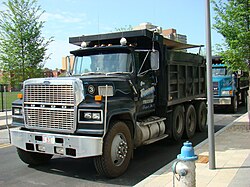Ford L series
| ford | |
|---|---|
|
1982–1996 Ford LTL-9000 dump truck
|
|
| Ford L series | |
| Manufacturer: | ford |
| Sales designation: | L series |
| Production period: | 1970-1998 |
| Previous model: | Ford F-Series heavy-duty trucks |
| Successor: | Sterling Trucks |
| Technical specifications | |
| Designs: | Dump truck , |
| Engines: |
Gasoline Engines : Ford Diesel Engines : Cummins Engine Caterpillar Detroit Diesel |
The Ford L-Series is a range of heavy duty trucks (trucks) that were built by Ford Motor Company between 1970 and 1998. They were produced in a new plant, the Kentucky Truck Plant near Louisville, Kentucky . The plant gave the series the nicknames Ford Louisville Line and Louisville Plant . The line became one of the most popular series Ford Trucks ever produced. These high-performance trucks replaced the short-lived, conventional Ford N-series and the heavy-duty trucks of the Ford F-series (but not the medium-duty F-series trucks that are still in production today) and the associated Ford T. -Series.
Model names
The designation L-series stood for the basic truck. Designations for other variants are listed below:
- LT = tandem axle.
- LN = Short Nose (compact hood), same wheelbase as LS, but shorter engine hood.
- LNT = Short Nose Tandem Axle.
- LS = front axle mounted further back and shorter wheelbase than L series.
- LTS = front axle mounted further back, with tandem rear axle.
- LTL = tractor unit with a long- hooded cab.
- Aeromax = aerodynamic version of the L series.
design
The design of the Ford L-series also influenced other Ford models. The Ford Torino and Ford Ranchero presented in 1972 had a hexagonal radiator grille that resembled that of the L series. In 1974, the W-series inherited the chrome-plated L-series grille. The Ford F-100 pickup presented in 1978 also got the hexagonal grille. In 1996, the L-series was redesigned with a sloping windshield and rounded front contours, the hexagonal front profile was also omitted. In addition, there were no longer any models with front axles mounted further back. These were restored when the entire heavy truck division was sold to Freightliner and the L-Series was marketed as Sterling Trucks .
LTL-9000
In 1976 Ford added the LTL-9000 to the program. This was specially designed as a construction vehicle and two years later received its own radiator grille and its own headlight arrangement.
Aeromax
The AeroMax appeared in 1988 and was basically a standard L-series truck. Innovations in aerodynamics were introduced with the Aeromax. It had a rear-mounted front axle, front fenders reaching deep into the wheel arch, and a smoother, fully-faired front bumper, among other minor changes. The first models were known as the Aeromax 9000 and later marketed as the Aeromax 120 and Aeromax 106. After the revision of the L series in 1996, they were offered as the Aeromax 9500.
End of production as Ford
In late 1996, shortly after the L-Series was reworked, Ford sold its entire heavy truck division to Freightliner , which was a former division of the White Motor Company . The L-Series was produced and marketed by Freightliner as Sterling Trucks using badge engineering .
literature
- Tad Burness: American Truck & Bus Handbook: 1920–1985
- Paul G. McLaughlin: Ford Heavy Duty Trucks 1948–1998
- James K. Wagner: Ford Trucks since 1905
- Ford Truck Chronicles, Editor of Auto Consumers Guide.
Individual evidence
- ↑ 1970 Ford Trucks, from auto editors from Consumer Guide
- ↑ [auto.howstuffworks.com/1970-1979-ford-trucks1.htm Ford Trucks 1970-1979]
- ↑ (1996 Ford Trucks)
- ↑ [auto.howstuffworks.com/1990-1999-ford-trucks7.htm Ford Trucks 1990-1999]

